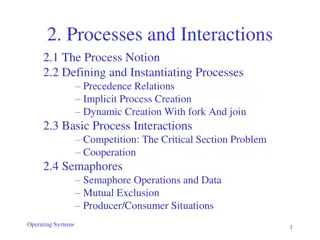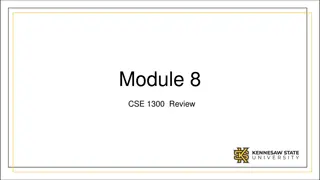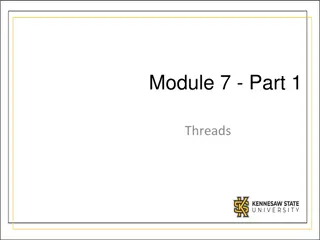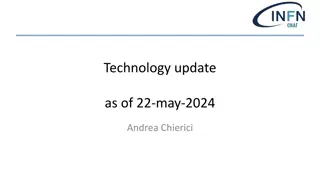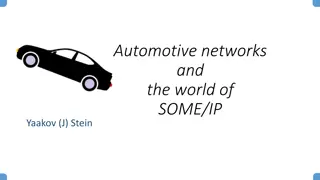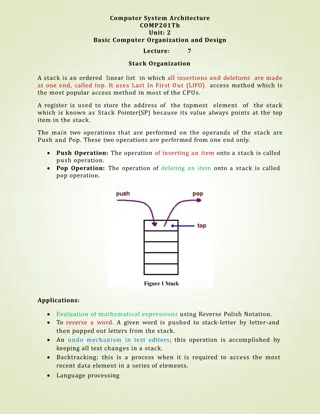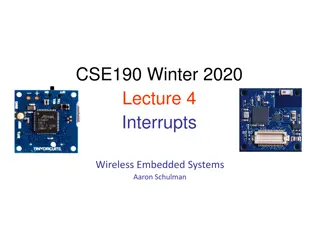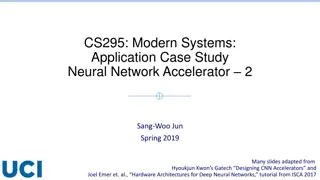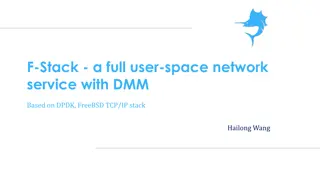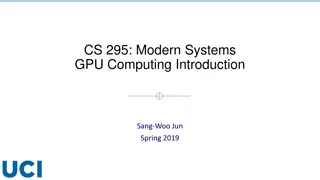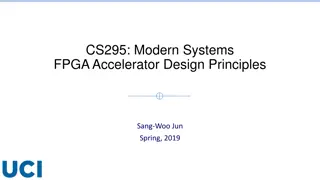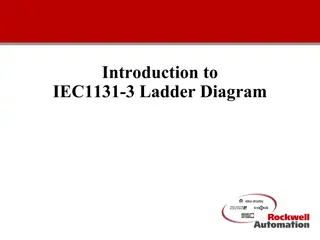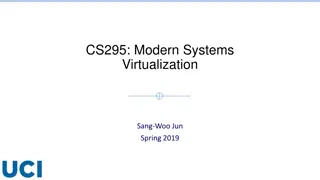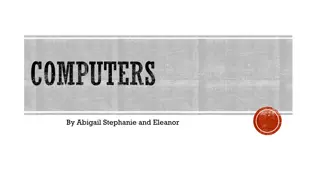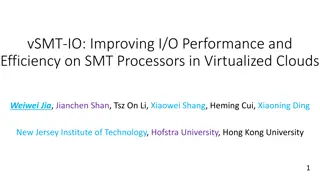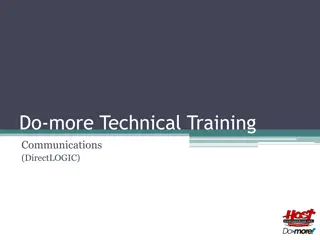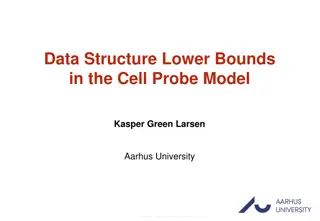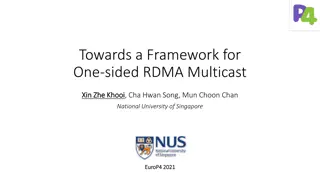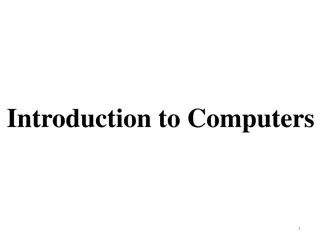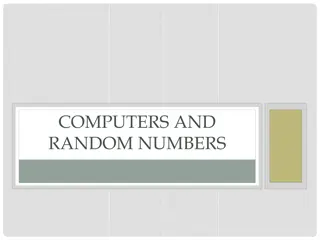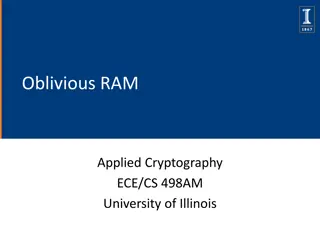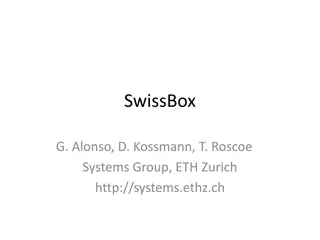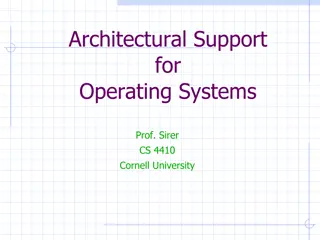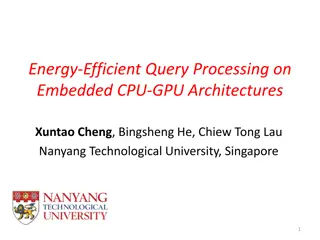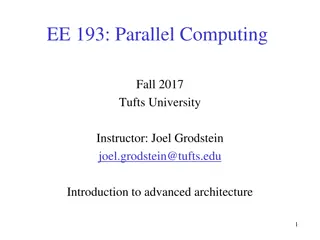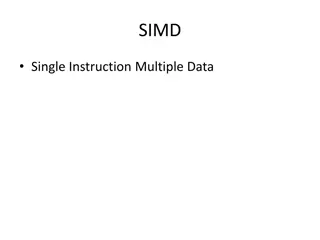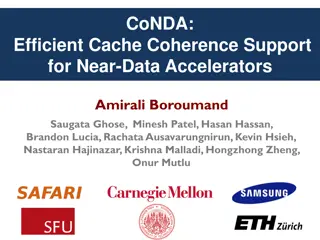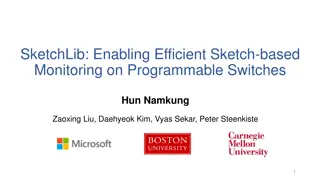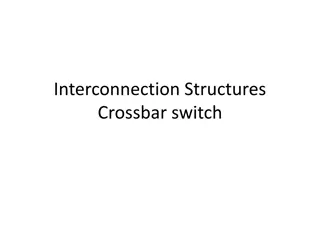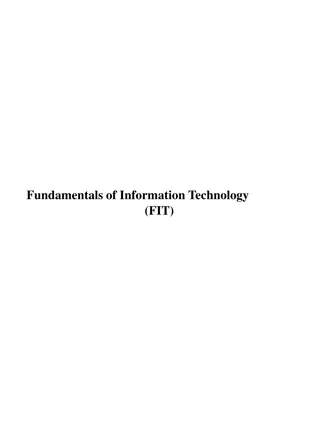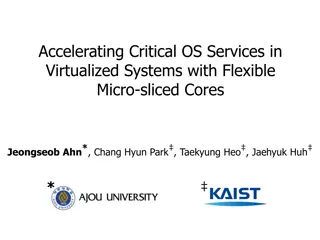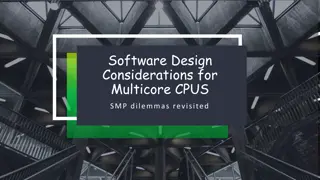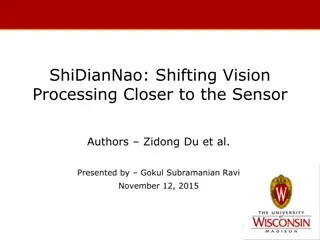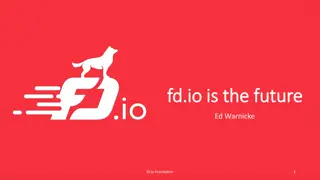Overview of Distributed Systems: Characteristics, Classification, Computation, Communication, and Fault Models
Characterizing Distributed Systems: Multiple autonomous computers with CPUs, memory, storage, and I/O paths, interconnected geographically, shared state, global invariants. Classifying Distributed Systems: Based on synchrony, communication medium, fault models like crash and Byzantine failures. Comp
9 views • 126 slides
Processes and Interactions
Processes in operating systems involve executing programs on CPUs, with each process having its own CPU. Processes run concurrently and can cooperate or compete for resources. Defining, creating, and managing processes is crucial for system efficiency and performance. Precedence relations, semaphore
1 views • 38 slides
Understanding Computer Components and Binary Numbers in Computing
Computer components like the case, power supply unit, motherboard, and storage devices play crucial roles in a computer system. CPUs consist of essential parts like the ALU, control unit, and registers. Binary numbers, a base-2 numbering system, simplify data representation and processing in computi
1 views • 44 slides
Understanding Threads in Computing
Exploring the concepts of parallel, distributed, and concurrent computing processes and how threads, cores, and CPUs work together. Delve into the terminology, implementation in Java and C#, synchronization, and the importance of leveraging multiple cores for enhanced performance.
0 views • 24 slides
Technology Update and Market Trends Overview
Explore the latest advancements in technology update, general market trends, major players in the data center industry, future fabrication processes, server market shifts towards AI and cloud, the rise of liquid cooling, CPU developments, and trends in CPUs with increasing core counts and new archit
0 views • 28 slides
Overview of Distributed Operating Systems
Distributed Operating Systems (DOS) manage computer resources and provide users with convenient interfaces. Unlike centralized systems, DOS runs on multiple independent CPUs and prioritizes software over hardware. It ensures transparency and fault tolerance, with a focus on software error handling.
1 views • 36 slides
Exploring Automotive Networks and ECUs in the World of SOME/IP
In the realm of automotive networks, Electronic Control Units (ECUs) play a vital role in managing various aspects of a vehicle's systems. Modern ECUs are sophisticated with Systems on Chip (SoCs) containing CPUs, memory, I/O ports, and communication interfaces. With examples of different types of E
1 views • 101 slides
Stack Organization in Computer Systems
A stack is an ordered linear list where insertions and deletions occur at one end, known as the top. It follows the Last In First Out (LIFO) access method and is commonly used in CPUs. Key operations include Push (inserting) and Pop (deleting) items from the stack. Applications include evaluating ma
0 views • 5 slides
Understanding Interrupts in Embedded Systems
In embedded systems, interrupts play a crucial role in letting peripherals notify the CPU of state changes. They are events external to the current process that disrupt the normal flow of instruction execution, typically generated by hardware devices. By using interrupts, CPUs can efficiently handle
1 views • 12 slides
Understanding Shared Memory Architectures and Cache Coherence
Shared memory architectures involve multiple CPUs sharing one memory with a global address space, with challenges like the cache coherence problem. This summary delves into UMA and NUMA architectures, addressing issues like memory latency and bandwidth, as well as the bus-based UMA and NUMA shared m
0 views • 27 slides
Understanding the Need for Neural Network Accelerators in Modern Systems
Neural network accelerators are essential due to the computational demands of models like VGG-16, emphasizing the significance of convolution and fully connected layers. Spatial mapping of compute units highlights peak throughput, with memory access often becoming the bottleneck. Addressing over 300
0 views • 21 slides
Optimizing User-Space Network Services with F-Stack and FreeBSD TCP/IP Stack
F-Stack, a user-space network service using DPDK and FreeBSD TCP/IP stack, addresses challenges in handling service traffic like CDN and live streaming. By leveraging 25GbE, 40GbE, and 100GbE NICs, coupled with multi-core CPUs and kernel bypass techniques, F-Stack overcomes bottlenecks between user
1 views • 17 slides
Understanding Modern GPU Computing: A Historical Overview
Delve into the fascinating history of Graphic Processing Units (GPUs), from the era of CPU-dominated graphics computation to the introduction of 3D accelerator cards, and the evolution of GPU architectures like NVIDIA Volta-based GV100. Explore the peak performance comparison between CPUs and GPUs,
5 views • 20 slides
FPGA Accelerator Design Principles and Performance Snapshot
This content explores the principles behind FPGA accelerator design, highlighting the extreme pipelining via systolic arrays that enables FPGAs to achieve high speeds despite lower clock frequencies compared to CPUs and GPUs. It delves into the application of Flynn's Taxonomy, performance snapshots
0 views • 17 slides
Comprehensive Guide to IEC1131-3 Ladder Diagram Programming
The origins of ladder diagram programming trace back to the graphical representation of electrical control systems, evolving from relay logic to logic circuits and finally incorporating CPUs for control decisions. A ladder diagram consists of rungs containing input and output instructions, executing
0 views • 21 slides
Understanding Virtualization in Modern Systems
Virtualization plays a crucial role in modern systems by improving portability, security, and efficient resource utilization. Historical uses, examples like IBM VM/370, and benefits in cloud environments are discussed. The working of virtualization, including naive software interpreters and protecte
1 views • 18 slides
Understanding Shared Memory Architectures and Cache Coherence
Shared memory architectures involve multiple CPUs accessing a common memory, leading to challenges like the cache coherence problem. This article delves into different types of shared memory architectures, such as UMA and NUMA, and explores the cache coherence issue and protocols. It also highlights
2 views • 27 slides
A Comprehensive Guide to Computers and Their Evolution
Exploring the world of computers from its inception to modern-day innovations. Understand the history, functions, and advancements in computer technology, including details on CPUs, memory, laptops, and mobile devices like phones and tablets.
5 views • 10 slides
Memory Consistency Models and Sequential Consistency in Computer Architecture
Memory consistency models play a crucial role in ensuring proper synchronization and ordering of memory references in computer systems. Sequential consistency, introduced by Lamport in 1979, treats processors as interleaved processes on a shared CPU and requires all references to fit into a global o
1 views • 64 slides
Enhancing I/O Performance on SMT Processors in Cloud Environments
Improving I/O performance and efficiency on Simultaneous Multi-Threading (SMT) processors in virtualized clouds is crucial for maximizing system throughput and resource utilization. The vSMT-IO approach focuses on efficiently scheduling I/O workloads on SMT CPUs by making them "dormant" on hardware
0 views • 31 slides
DirectLOGIC Communications Training Overview
Explore the technical training communications for Do-more DirectLOGIC systems, focusing on setting up communication between DL Servers and Clients using built-in Ethernet ports and ECOM100 modules. Learn about communication configurations, memory allocation, and parameter settings to establish effec
0 views • 28 slides
Understanding Lower Bounds in the Cell Probe Model
Exploring the concept of lower bounds for static data structures, this content delves into the tradeoffs between query time and space efficiency. It discusses the need for proving lower bounds, the model of data structures, and how CPUs access memory in computational devices. Kasper Green Larsen fro
0 views • 45 slides
Framework for One-sided RDMA Multicast in Data Center Group Communications
This paper explores the implementation of one-sided RDMA multicast in data center group communications, highlighting the benefits of offloading network I/O from CPUs and unique connection parameters for efficient multicast operations. The research addresses the challenges of enabling one-sided RDMA
0 views • 11 slides
Introduction to Computers: Understanding Hardware and Input Devices
Computers are electronic devices that process input to produce information. They consist of hardware components like CPUs, input/output units, and memory. Input devices such as keyboards, mice, and scanners help translate human-readable data for computer processing.
0 views • 11 slides
Understanding Random Numbers in Computers
Explore the concept of true random numbers versus pseudorandom numbers in computers. Learn how pseudorandom numbers are generated algorithmically but predictable, while true random numbers are derived from physical phenomena like radioactive decay. Discover the relevance of high-entropy pseudorandom
0 views • 57 slides
Oblivious RAM and Software Protection: An Overview
Oblivious RAM (ORAM) and software protection against piracy involve securing hardware and encrypted programs to prevent unauthorized access. With a focus on achieving security through encryption and indistinguishability, concepts like access patterns and data request sequences play a crucial role. T
0 views • 26 slides
Overview of SwissBox Project at ETH Zurich
SwissBox project at ETH Zurich, led by G. Alonso, D. Kossmann, and T. Roscoe, focuses on building a high-performance system called SwissBox. It encompasses hardware components like CPUs, memory, FPGAs, and storage, aiming to create a versatile computing platform. The project explores shared i-disk a
0 views • 18 slides
Understanding Device Interfacing in Operating Systems
Explore the architectural support for operating systems, basic computer organization, keyboard mechanics, and device interfacing techniques such as memory-mapped I/O, polling vs. interrupts. Learn how CPUs interact with devices and the mechanisms behind efficient data processing in computer systems.
0 views • 29 slides
Energy-Efficient Query Processing on Embedded CPU-GPU Architectures
This study explores the energy efficiency of query processing on embedded CPU-GPU architectures, focusing on the utilization of embedded GPUs and the potential for co-processing with CPUs. The research evaluates the performance and power consumption of different processing approaches, considering th
0 views • 22 slides
Understanding Advanced Computer Architecture in Parallel Computing
Covering topics like Instruction-Set Architecture (ISA), 5-stage pipeline, and Pipelined instructions, this course delves into the intricacies of advanced computer architecture, with a focus on achieving high performance by optimizing data flow to execution units. The course provides insights into t
0 views • 12 slides
Understanding SIMD in Computer Architecture
SIMD (Single Instruction Multiple Data) architecture plays a crucial role in optimizing performance for parallel computing tasks. It allows for the simultaneous processing of multiple data elements, enhancing efficiency in various applications. The concept is rooted in executing the same operation a
0 views • 24 slides
Optimizing Coherence Mechanisms for Near-Data Accelerators
Coherence mechanisms play a crucial role in supporting efficient communication between Near-Data Accelerators (NDAs) and CPUs. The CoNDA framework introduces an optimistic approach to coherence, aiming to reduce unnecessary off-chip data movement and enhance performance. By gaining insights before c
0 views • 55 slides
Enhancing Efficiency in Sketch-based Monitoring for Programmable Switches
SketchLib introduces advancements in sketching algorithms to enable efficient monitoring on programmable switches. The tool bridges gaps between existing sketches for CPUs and programmable switches, offering resource optimizations and API calls to enhance performance and reduce resource consumption
0 views • 20 slides
Understanding Crossbar Switch Interconnection Structures
Interconnection structures like crossbar switches consist of crosspoints that control the pathways between processors and memory modules. The switch determines the transfer path and resolves access requests on a priority basis. Through multiplexers and arbitration logic, crossbar switches enable sim
0 views • 6 slides
Understanding Basics of Computer: Chapter 1 in Fundamentals of Information Technology (FIT)
Computers play a crucial role in our daily lives, impacting various aspects such as work, entertainment, and communication. This chapter delves into the history of computer development, the definition of a computer, hardware and software components, memory functions, and the interaction between CPUs
0 views • 21 slides
Accelerating Critical OS Services in Virtualized Systems
The research discusses accelerating critical OS services in virtualized systems using flexible micro-sliced cores. Challenges in server consolidation, tackling virtual time discontinuity, shortening time slice, and dividing CPUs into pools are highlighted. The approach involves serving critical OS s
0 views • 19 slides
Software Design Considerations for Multicore CPUs
Discussion on performance issues with modern multi-core CPUs, focusing on higher-end chips and boards. Exploring the concept of cores, chips, and boards in the context of multicore CPUs and their memory architectures.
0 views • 31 slides
ShiDianNao: Advancing Vision Processing Closer to Sensors
Neural network accelerators are achieving high energy efficiency and performance for recognition and mining applications. To overcome memory bandwidth constraints, the proposal suggests mapping the entire CNN into SRAM and moving closer to sensors to minimize memory access for I/O. Placing the CNN a
0 views • 24 slides
The Future of Fast Data Processing with fd.io VPP
Explore the future of fast data processing through the innovative fd.io VPP technology. VPP stands as a high-performance packet processing platform running on commodity CPUs. It leverages DPDK for optimal data plane management and boasts fully programmable features like IPv4/IPv6 support, MPLS-GRE,
0 views • 15 slides

